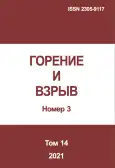Theoretical analysis of the method of tests of solid explosives for sensitivity to mechanical impact — destructive shell
- 作者: Dubovik A.V.1
-
隶属关系:
- N.N. Semenov Federal Research Center for Chemical Physics of the Russian Academy of Sciences
- 期: 卷 14, 编号 3 (2021)
- 页面: 130-142
- 栏目: Articles
- URL: https://bakhtiniada.ru/2305-9117/article/view/288590
- DOI: https://doi.org/10.30826/CE21140312
- ID: 288590
如何引用文章
详细
A theoretical analysis of the original test method for determining the level of sensitivity of solid explosives to mechanical stress, called Destructive Shell (DS), was carried out. It belongs to the number of nonimpact test methods when an explosive charge compressed to high pressure is suddenly released from it and freely scattered around. It is argued that in the process of high-speed movement, the fragments of destruction are compressed by the parts of the test device with simultaneous physical and mechanical interaction with them as well as with each other through heat exchange contacts and chemical reactions. The situation is generally similar to that which arises in the process of destruction of an explosive charge upon mechanical impact. Therefore, to analyze the DS method, the mathematical procedure for calculating the parameters of flows and temperatures of dissipative heating of the destroyed charge substance, previously developed for calculating an explosion upon impact, was used. The data obtained made it possible to clarify the formulations of the two main mechanisms of initiation of solid explosives by the DS method, namely, viscous-plastic and frictional heating.
作者简介
Alexander Dubovik
N.N. Semenov Federal Research Center for Chemical Physics of the Russian Academy of Sciences
编辑信件的主要联系方式.
Email: a-dubovik@mail.ru
Doctor of Science in physics and mathematics, professor, leading research scientist
俄罗斯联邦, 4 Kosygin Str., Moscow 119991参考
- Shchetinin, V.G. 1999. Estimation of the mechanical sensitivity of solid explosives by the disintegrating-shell method. Combust. Explo. ShockWaves 35(5):570–575.
- Teselkin, V.A. 2008. Effect of particle size of the components on the mechanical sensitivity of metallized explosives. Russ. J. Phys. Chem. B 2(5):609–616.
- Afanasiev, G.T., and V.K. Bobolev. 1971. Initsiirovanie tverdykh vzryvchatykh veshchestv udarom [Initiation of solid explosives by impact]. Moscow: Nauka. 178 p.
- Dubovik, A. V. 2011. Chuvstvitelnost’ tverdykh vzryvchatykh sistem k udaru [Sensitivity of solid explosives systems to impact]. Moscow: Mendeleev University of Chemical Technology Publs. 276 p.
- Bowden, F. P., and A.D. Ioffe. 1952. Initiation and growth of explosion in solids and liquids. Cambridge University Press . 120 p.
- Amosov, A. P. 2011. Teplofizicheskie modeli treniya inertnykh i vzryvchatykh materialov [Thermophysical models of friction of inert and explosive materials]. Moscow: Mashinostroenie. 364 p.
- Makhov, M.N. 2021. Prognozirovanie metatel’noy sposobnosti smesey vzryvchatykh veshchestv s gidridom alyuminiya [Prediction of the acceleration ability of explosive mixtures with aluminum hydride]. Goren. Vzryv (Mosk.) — Combustion and Explosion 14(1):83–86.
- Dubovik, A. V., and R. V. Panafidin. 2018. Chuvstvitel’nost’ k udaru smesey oktogena s oksidom zheleza [Sensitivity to impact of mixtures of octogen with iron oxide]. Goren. Vzryv (Mosk.) — Combustion and Explosion 11(4):68–73.
- Khariton, Yu.B. 1946. Sbornik statey po teorii VV [Collection of papers on the theory of explosives]. Moscow: Oborongiz. 177–202.
- Kachanov, L.M. 1969. Osnovy teorii plastichnosti [Fundamentals of plasticity theory]. Moscow: Nauka. 420 p.
补充文件









